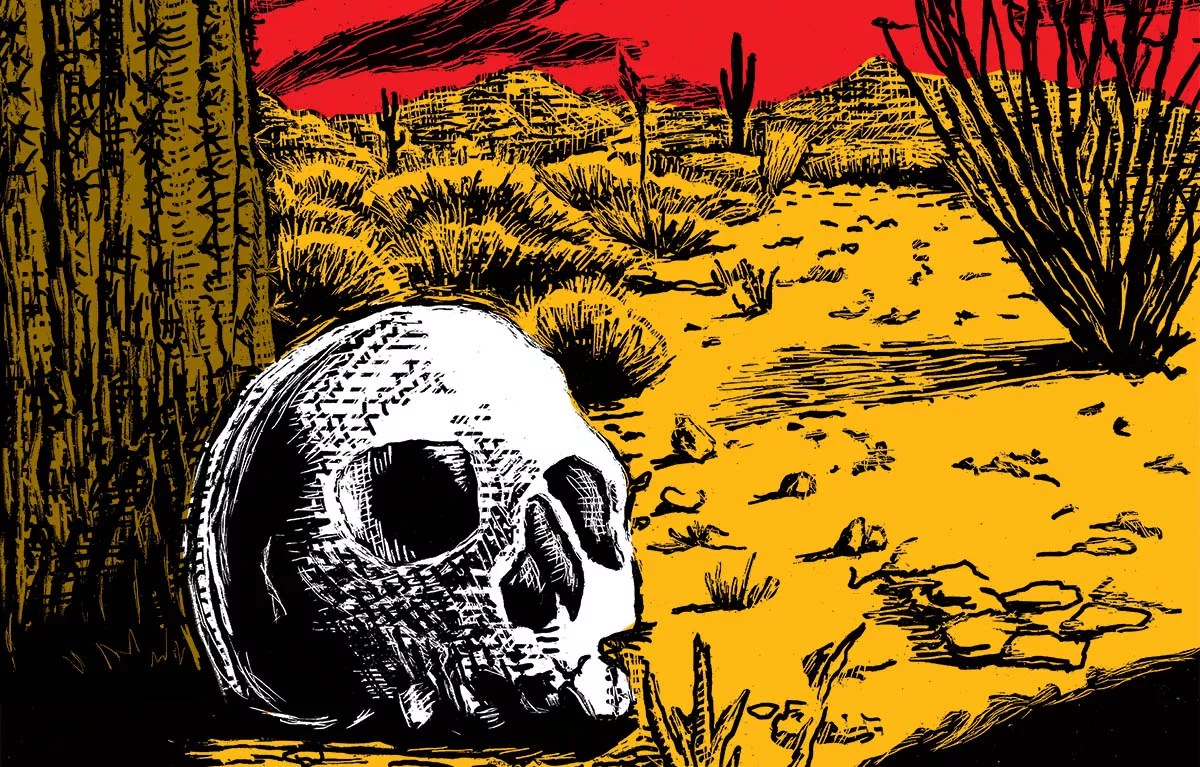
Tom Carlson

Audio By Carbonatix
It only took about an hour of hiking through Growler Valley before a member of Battalion Search and Rescue spotted some bones.
“We’ve got human remains,” a voice announced grimly over the radio.
The volunteers – eight men and women, mostly in their 30s – had started out the day by parking their cars at the Devil’s Highway, a remote route that runs between Yuma and Ajo, Arizona, that was historically used by Native Americans, Spanish conquistadors, and gold prospectors traversing the Sonoran Desert. Spread out in a line roughly a quarter of a mile, they’d headed north on foot through Organ Pipe Cactus National Monument and the Cabeza Prieta National Wildlife Refuge.
Occasionally, the hikers came across a piece of clothing, a water bottle, a backpack, or a .50 caliber bullet casing leftover from bombing and live-fire exercises at the nearby Barry M. Goldwater Air Force Range. But signs of human life are largely absent in this harsh and unforgiving landscape. The southern Arizona sun, 15 miles from the Mexico border, was brutally hot, even in the early hours of a March morning. The intimidating Growler Mountains loomed over the flat and exposed desert expanse from the east. Shade could be found under the sparse trees that lined a sprawling wash that snaked through the Growler Valley. But to reach the trees often meant passing through thickets of dry, thorny brush that surrounded them.
Phoenix, make your New Year’s Resolution Count!
We’re $14,000 away from our End-of-Year campaign goal, with just a five days left! We’re ready to deliver — but we need the resources to do it right. If New Times matters to you, please contribute today to help us expand our current events coverage when it’s needed most.
The members of the group promptly converged on the discovery: a highly weathered set of human bones, including ribs, leg bones, and part of a pelvis. Nearby was a human skull with most of its frontal features and the jaw bone missing.
Battalion Search and Rescue documented the site and marked it, then moved along. Over the course of its two-day trek, which required overnight camping in the desert and 18 miles of hiking, the group found five more sets of bones. James Holeman, Battalion Search and Rescue’s founder, calls this region “one of the deadliest, if not the deadliest corridor” in Arizona for migrant traffic.
Hundreds of sets of human remains are found every year in southern Arizona, many of them belonging to migrants who’ve crossed the Mexico border seeking a better life in America. According to Humane Borders, a nonprofit organization that tracks migrant remains recovered by local medical examiners, 227 separate sets of remains were found in Arizona in 2020 – 220 of them were located in Pima County alone.
The work of finding, recovering and identifying suspected dead migrants along the border is less formalized than one might imagine, given those large numbers. It isn’t often a high priority for local law enforcement – activists say police departments and sheriffs’ offices are slow to recover remains, or even get them at all – and limited resources constrain officials’ ability to quickly identify remains. Boxes of bones are quite literally piling up in the Pima County Office of the Medical Examiner. Instead, a patchwork of government agencies, nonprofit organizations, and humanitarian groups like Battalion Search and Rescue take up the effort.
“We have an obscene number of human remains that are recovered in the Arizona borderlands every year,” said Cheryl Opalski, a volunteer with the Ajo Samaritans, a humanitarian aid group based in Ajo. “People are getting lost and dying in the desert every year in large numbers. There is limited response. It’s upsetting.”
How Arizona Became a Graveyard
Migrants weren’t always dying en masse in southern Arizona. Before 2000, less than 30 sets of migrant remains were recovered each year by the Pima County Office of the Medical Examiner, according to a 2013 report from the University of Arizona and the Binational Migration Institute. At the time, border security was more lax, and migrants seeking to enter the United States unlawfully from Mexico could easily cross in urban areas like Tijuana and Ciudad Juárez relatively easily.
“People used to be able to just walk or swim across the Rio Grande depending on the season, come up into downtown El Paso, and then somebody would be arranged to pick them up, or they’d take public transportation north into the United States,” said Josiah Heyman, a professor of anthropology at the University of Texas at El Paso who studies U.S.-Mexico border issues. “Less than half of the people that crossed needed a smuggler. And the smuggling fees were a lot lower.”
That changed in the mid-1990s, when the federal government, under President Bill Clinton’s administration, began bulking up security and Border Patrol presence in cities with historically high numbers of migrant traffic.
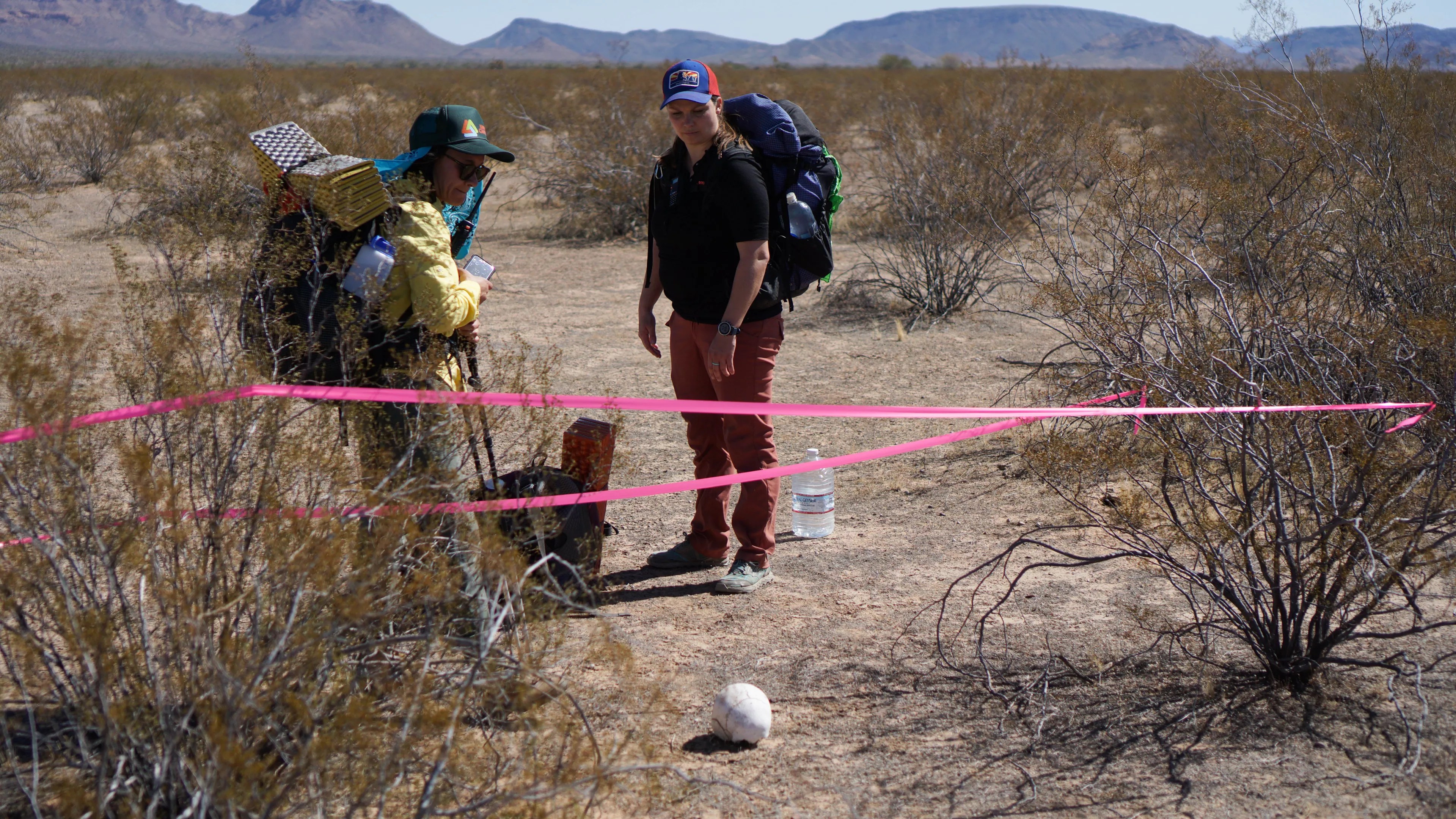
Volunteers with Battalion Search and Rescue stand near a skull found on March 6, 2021.
Josh Kelety
The plan, called the 1994 Southwest Border Strategy, sought “prevention through deterrence.” A Border Patrol document outlining the strategy predicted that migration would be “forced over more hostile terrain, less suited for crossing and more suited for enforcement.” The initiative resulted in the purchase of new fencing, lighting, underground sensors, helicopters, and other equipment, as well as the creation of hundreds of new Border Patrol jobs in border regions, including Arizona. In 1993, the Tucson sector had 281 Border Patrol agents. Four years later, it had 817, according to a 1997 report from the U.S. General Accounting Office (GAO).
As a result, migrant traffic shifted to more remote parts of the border and away from urban areas where security had been beefed up. (Immigration officials reportedly told the GAO that they were “surprised” that migrants quickly started crossing more difficult terrain that they believed would serve as a “barrier.”)
Migrant deaths also skyrocketed. In 1999, the Pima County Office of the Medical Examiner conducted autopsies on 19 suspected migrants. The following year, that number shot up to 71. In 2005, the office processed 195 sets of remains. A 2006 study produced by the Binational Migration Institute found an “exponential increase” in migrant remains recovered in Arizona by the Pima County Office of the Medical Examiner between 1990 and 2005. The analysis also noted that the “prevention through deterrence” policies instituted during the 1990s created a “funnel effect” that forced migrants into “Arizona’s perilous and deadly landscape.”
Though the tally of migrants apprehended while trying to cross the U.S.-Mexico border has been falling since it peaked in the early 2000s, the number of suspected migrant remains found in Arizona has stayed high. The number of skeletal remains recovered by Pima County officials has also been increasing, while recoveries of remains that are less decomposed (e.g. fully fleshed bodies) are dropping.
To experts, these trends suggest that migrants are still regularly crossing in remote regions of Arizona, where bodies degrade quickly – the combination of the elements and animals can make quick work of a corpse. And an increasingly larger share of identifiable remains are people from Central America, an indicator of changing migration patterns.
Daniel Martinez, an associate professor of sociology at the University of Arizona who studies immigration and migrant deaths at the U.S.-Mexico border, said that observers have seen a “significant shift” of groupings of suspected migrant remains found in Arizona to the Growler Valley, Organ Pipe Cactus National Monument, and the western boundary of the Tohono O’odham Nation.
“This is a response to increased Border Patrol presence,” he said. “Although apprehensions are down, people are still crossing, people are still dying, and migrants are taking even more remote routes to avoid detection. The data does bear that out.”
Looking for the Lost
Holeman, the Battalion Search and Rescue founder, has been venturing out into Arizona’s wilds seeking bones and bodies for years. Originally from Chicago, he’s a veteran who served as a reservist in the Marine Corps during the Gulf War. After college, he spent some time in Hawaii before moving to Arizona in 2007. He began volunteering with search groups after reading some news articles about humanitarian efforts at the border. A body discovered by James Holeman during a search in 2019 with Aguilas del Desierto. Photo courtesy James Holeman
“I’m trying to help humanize migrants and decriminalize their journey,” he said. “I personally see it as heroic, their journey.”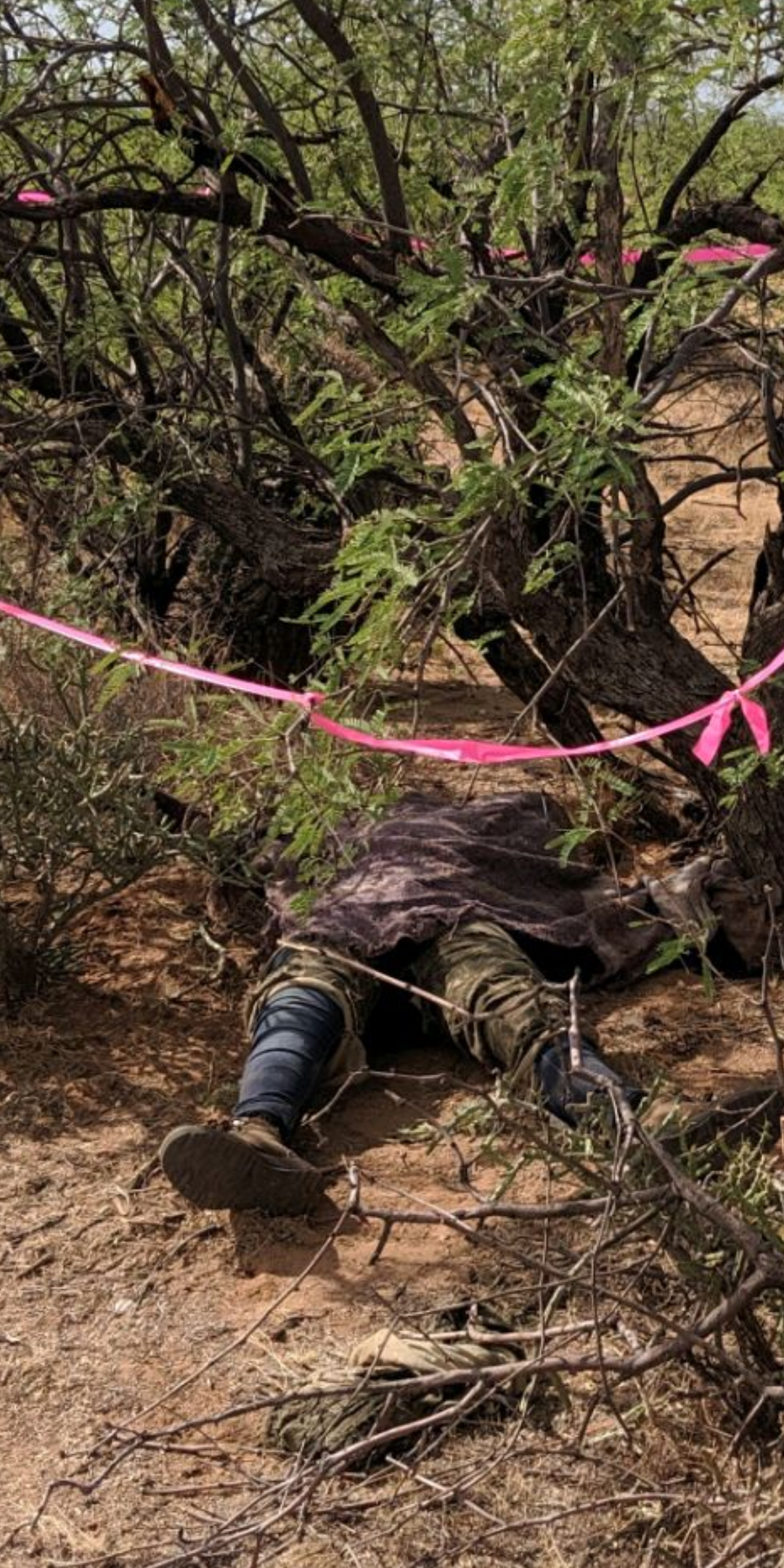
In 2019, Holeman, then a volunteer with the San Diego-based group Aguilas del Desierto, found the body of a young migrant woman near Tucson by following a vulture circling overhead (it was the second body that the group had found in 24 hours). He was also part of a search in the Growler Valley where the group found ten separate sets of human remains. Holeman claimed that he’s found close to a “dozen” bales of marijuana in the desert as well as radios and binoculars, items presumably abandoned by drug traffickers or those known as coyotes – people who guide migrants through the desert. On one trip, Holeman said someone speaking profanity-laden Spanish hopped on to his group’s radio frequency and began cussing them out. He believes it was a scout working for a cartel or coyotes.
In 2020, Holeman founded a new search group, Battalion Search and Rescue. He says the inspiration for the name came from the story of Saint Patrick’s Battalion, a military unit consisting primarily of American Irish Catholics who fought for the Mexicans during the Mexican-American war. The group, which Holeman describes as a “lean and mean” operation (a professional nurse typically joins the searches, in case of medical emergencies), strives to cover wide swaths of territory in search of migrant remains. The goal is to get remains identified so that family members can be notified of the death.
The volunteers who work as part of Battalion Search and Rescue mostly hail from Arizona. Some, like Holeman, have past experience with other volunteer search groups. Others are new to the work. One volunteer, Jim Herrera, got involved after twice encountering migrants in distress on Interstate 8 near Gila Bend while driving between Tucson from San Diego. Kevin Tangney, a 41-year-old combat veteran of the Iraq War, is a former outdoors guide who stumbled across Holeman’s group through social media. His politics and expertise aligned with the group’s mission, so he joined up.
“There’s nothing like being a soldier for years to turn you into an anarchist,” he said.
When the goal is to find dead bodies and bones, success is inevitably grim. During a search last October, after having already found several sets of partial skeletal remains, the group stumbled across a mummified body of a man from El Salvador. He was carrying a mask, IDs, and a passport. Holeman worked with César Ortigoza, who is originally from Mexico and is the founder of another search group, to reach the man’s family in El Salvador.
“She said they were poor, they didn’t have any options,” Holeman said. “He had a young son, 21. They asked César to go back and put a cross [where he died].”
“It’s horrible,” he added. “It’s heartbreaking.”
When members encounter remains, the group documents the site with pictures, logs its GPS coordinates, and cordons it off with pink tape to make it easy for law enforcement to spot. Afterward, Holeman reports the discovered remains to local law enforcement – typically the Pima County Sheriff’s Office – as well as other federal agencies that oversee the land, such as the National Park Service, which runs Organ Pipe Cactus National Monument, or U.S. Fish and Wildlife, the agency that manages the massive Cabeza Prieta National Wildlife Refuge. But despite the (sometimes literal) leg work by Holeman’s search group, contacting law enforcement hardly guarantees that a family of a migrant will be quickly notified their loved one has died alone out in the desert.
Delayed Responses
An estimated 50 percent of suspected migrant remains are found by Border Patrol agents during the course of their duties, according to Pima County Chief Medical Examiner Dr. Greg Hess. The rest are reported by a combination of hikers, hunters, ranchers, ATV drivers, and humanitarian search groups like Battalion Search and Rescue. They all call the same entity to come deal with the human remains: local law enforcement.
Hess, Holeman, and other humanitarian activists who work in the region say that the Pima County Sheriff’s Office regularly fails to quickly recover reported remains – or recover them at all.
“I can think of three instances off the top of my head over the last year where they said that they retrieved them and they absolutely did not retrieve them,” Holeman said.
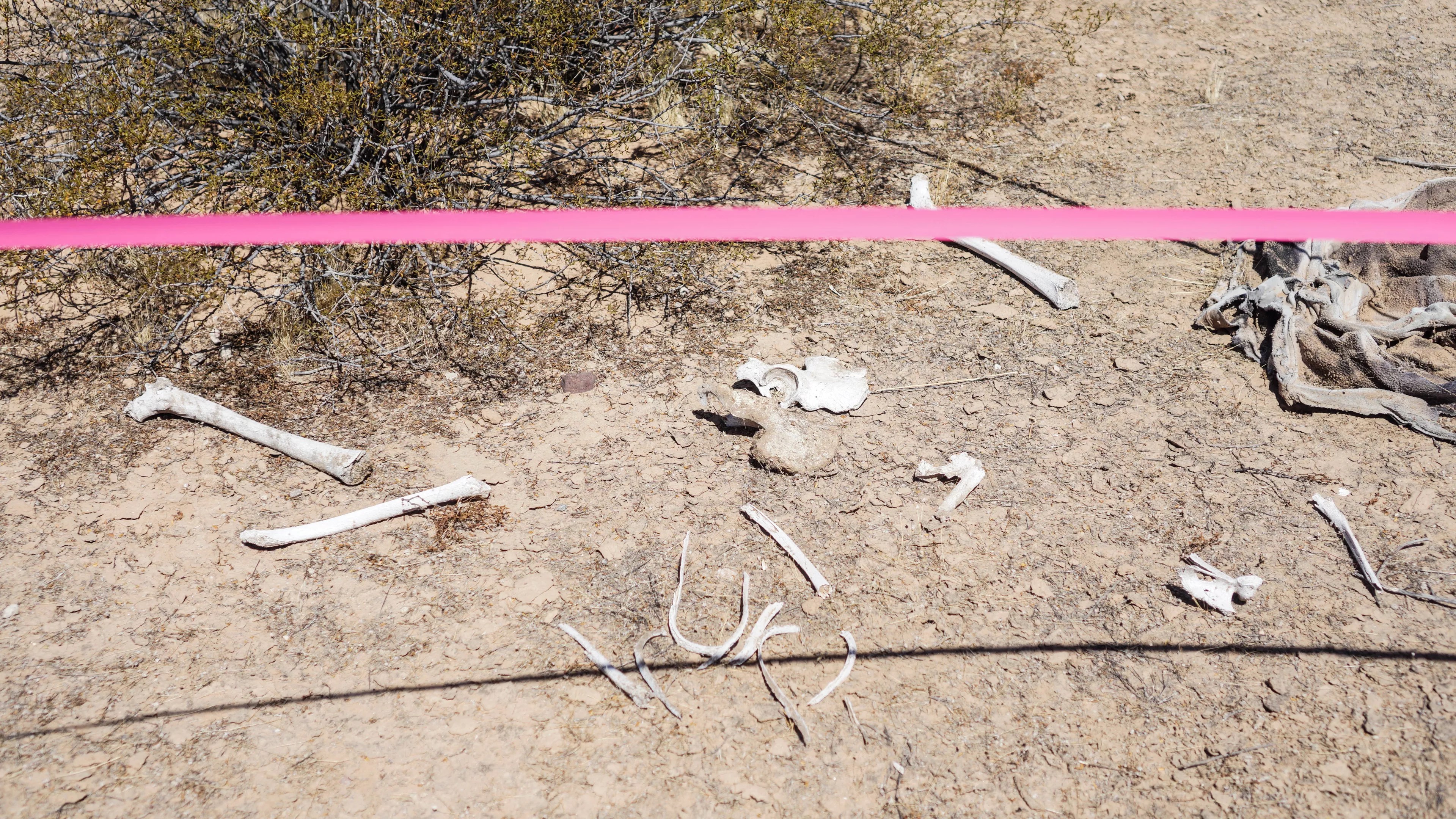
Suspected human remains found by Battalion Search and Rescue in the Growler Valley on March 6, 2021.
Josh Kelety
“We are made aware of some instances where somebody finds what they believe is human remains and they are not collected, period, or they are collected way later than when they are first found,” Hess echoed. “It’s a little bit frustrating, because we want to get our hands on those remains – we want to help identify those people.”
“With skeletal remains, the urgency isn’t there for them,” said Opalski, the volunteer with the Ajo Samaritans. “Often, I have to nudge several times before the recovery has been completed.”
Reached by phone, newly elected Pima County Sheriff Chris Nanos said that he “can’t answer” how the issue was handled under the previous administration. But he admitted that the agency doesn’t always prioritize the retrieval of skeletal remains.
“Clearly, if we have a human being, a body as you say, laying out on the floor of the desert somewhere, that’s going to get a lot more attention than if we find bones, clothing, or scattered bones,” he said. “A human body that hasn’t decayed, certainly we’d like to put that above any scattered bones.”
Nanos added that other factors can delay recoveries as well, such as weather and the location of remains. He cited an instance from last January where deputies tried to recover remains reported by a humanitarian group using dune buggies, but the terrain was too “rugged” to continue further. They possess a helicopter and three airplanes that can be used to retrieve remains, but other issues, like routine inspections mandated by the Federal Aviation Administration that require aircraft to be grounded for “weeks,” can delay their use.
Whatever the official rationale, the delays are frustrating for activists.
“I get it,” Holeman said. “Law enforcement and different government agencies are taxed, they’re under pressure and underfunded potentially. But this is a human life. I don’t think we’re treating them properly and equally as we would anybody else that’s in distress or that loses their life in the wilderness in our country.”
Boxes of Bones
Approximately 3,081 sets of suspect migrant remains were recovered by the Pima County Office of the Medical Examiner between 2000 and 2019. Of those, about two-thirds have been successfully identified, while the remaining third are effectively cold cases.
The backlog is on visual display at the Pima County Office of the Medical Examiner, where the bones of suspected migrants are currently stored in cardboard boxes in the hallway. Previously, these were kept in coolers, but they were relocated during the pandemic to accommodate COVID-19-related deaths.
“We kind of outgrew our facility here,” Dr. Hess said, fumbling with a box filled with several sets of bones. “All these would be considered long-term storage.”
Limited funding for DNA tests, the deteriorated state of bones, a lack of unique personal property items: These are some of the factors that stymie investigators’ efforts to identify suspected migrant remains. Bones can’t tell you if someone had any unique tattoos, for instance. And migrants are less likely to show up in databases and records maintained by American law enforcement and other agencies.
“Our odds of identifying someone are basically directly proportional to the condition of the remains when they come in and if they have any property items with them,” said Hess. “[If] you only have a couple bones, the odds of identifying that person go down, or it’s going to take a lot longer.”
The desert environment in southern Arizona is particularly brutal on bodies. “It’s hot, it’s dry. There’s a lot of insects and lots of animals,” Hess said. “People become skeletal remains relatively rapidly.”
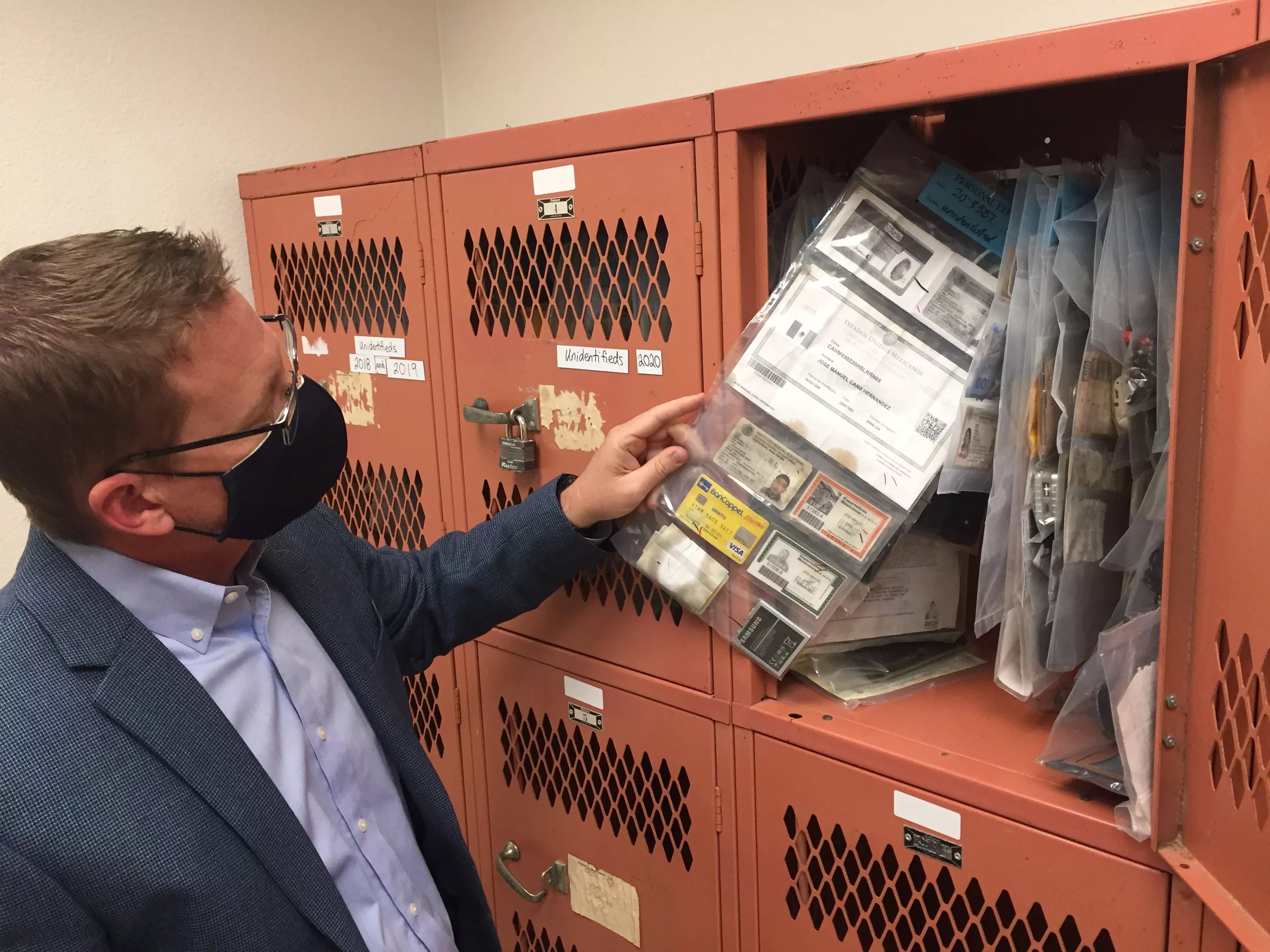
Dr. Greg Hess shows property items found among migrant remains recovered in southern Arizona.
Josh Kelety
Property items found with remains are very important in identifying people. Migrants will sometimes carry IDs, passports, letters, cellphones, bus tickets to border cities, receipts, or previous deportation documents – all of which can help piece together their identity and their activities before they died. Lately, masks have become a helpful “time stamp.”
DNA testing is effectively the only way to identify skeletal remains, and it’s often done in collaboration with non-governmental organizations and foreign consulates that work with families of migrants to process missing persons reports, take DNA samples, and provide other relevant information. But Pima County relies on inconsistent grant funding to finance tests conducted at outside labs, which can delay the process.
“We can’t do DNA unless we get money to do it,” Hess said. “In a matter of two, three years we’ll get several hundred samples that we’ll need to do DNA on – and then we may not do any DNA for two or three years until we get another grant funding cycle.”
Even when they are able to get DNA samples processed, it only provides partial information. Another sample from a relative is needed to provide a match and positively identify a person. Remains that are strictly bones can languish for months and years without being identified.
“If [a sample] were compared against a relative’s DNA, maybe that would result in something,” Hess said. “But we wouldn’t even know who to contact.”
The Tucson-based Colibrí Center for Human Rights works closely with the Pima County Office of the Medical Examiner to help identify remains. The organization regularly receives missing persons reports from families in Central America and Mexico and collects DNA samples from relatives to compare with samples taken from remains.
“We get 16 to 20 missing person reports per month,” said Tony Benagas, executive director of the Colibrí Center. “Last year, even with the pandemic, we think we broke a record.”
“That just shows you the desperation of many men and women,” Benagas added. “They’re always trying to find a better life for themselves and their families. The pandemic was not a deterrent.”